Table of Contents[Hide][Show]

Though it often gets mistaken for its look-alike, red cabbage, radicchio is actually a type of chicory which features prominently in Italian cuisine (which is why it’s sometimes referred to as Italian chicory!). Despite its small stature, this leafy “green” with a petite, compact, leafy head stands out because of its gorgeous burgundy-colored leaves featuring prominent white mid-ribs and veins, not to mention its distinctive spicy and bitter taste which mellows with cooking.
Radicchio is a member of the daisy family, which consists of over 2,500 species worldwide, including artichoke, chamomile, chicory, dandelion, lettuce, and sunflowers.
Radicchio (Cichorium intybus) is actually a member of the Asteraceae (or daisy family) which is one of the largest flowering plant families, consisting of over 2,500 species worldwide, including lettuce, sunflowers, artichoke, dandelion, chamomile, and chicory. Chicory is an herbaceous group of plants whose members have been used in traditional medicine for thousands of years and whose roots, after roasting and grinding can be used as a coffee substitute. This group includes many members cultivated for salad leaves, with one of the most well-known being Belgian endive. Radicchio, specifically, has been cultivated in Italy since the 15th century, but the version we now know and love was actually engineered much later in 1860 by a Belgian crop scientist. He cultivated the plant in a unique manner, employing a blanching technique, where plants are taken from the soil and placed in water in darkened sheds, in essence inhibiting chlorophyll production, resulting in the stunning coloring of this leafy “green”!
Radicchio is cultivated in a unique manner in order to obtain its stunning coloring.
There are actually many varieties of radicchio, each named after the region in Italy where they originated, however in North America you’re only likely to encounter a few types. The most common and widely available type is the Chioggia variety, which was developed in the 1900s for its round, compact head. Treviso has similar coloring with a longer, looser-leafed head (like Romaine lettuce), while Castelfranco has light green leaves with deep red speckling (a cross between escarole and radicchio). In Italy, Tardivo is considered the king of radicchio; it is a gourmet specialty requiring weeks of manual labor to produce the stunning variety with bright white stalks and red leaves that curl inwards at their tops! As you might expect radicchio is predominantly cultivated in the Mediterranean region (specifically Italy), but is now also grown commercially in other places like California and Mexico. If its bitter reputation has left you too intimidated to cook with it thus far, don’t be “radicchio-lous”, give it a try! You just might love it.
The Best Support to Build This Important Daily Habit!

Nutrivore Salad-a-Day Challenge
The Nutrivore Salad-a-Day Challenge e-book explains all the ways a daily salad can improve your health, plus includes a collection of 10 handy visual guides and food lists, like the Nutrivore Salad Matrix.
Plus, you’ll find 50+ recipes, including over 30 of our favorite salad recipes plus recipes for delicious dressings and tasty toppers.
Buy now for instant digital access.
Nutrivore Score for Radicchio – 2471
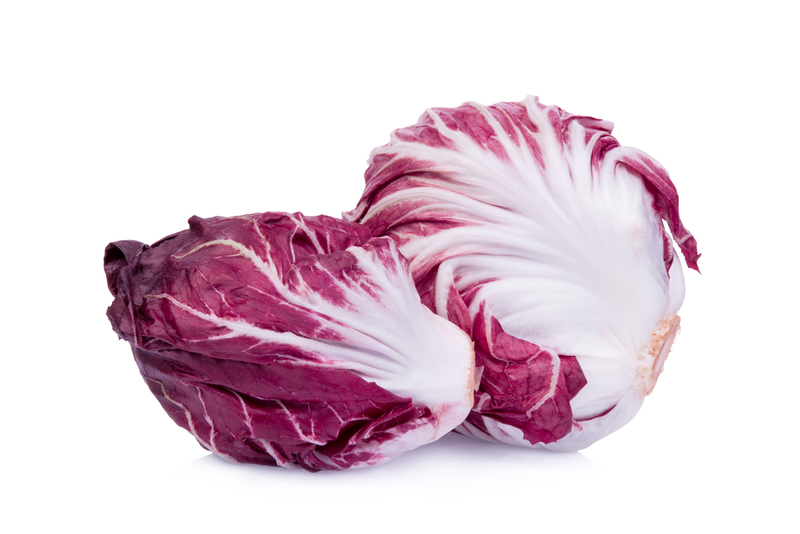
Radicchio has a Nutrivore Score of 2471, making it a super nutrient-dense food! Plus, it is a low-carb and low-calorie-density food; amazingly the calorie count of radicchio is just 9 calories per cup!
Per serving, radicchio is a best source (>50% daily value) of carotenoids, polyphenols, and vitamin K; is an excellent source (20-50% daily value) of copper; and is a good source (10-20% daily value) of vitamin B9 (folate) and vitamin E.
Ditch Diets. Embrace Nutrients. Start with this FREE Guide.
Sign up for the free Nutrivore Newsletter, your weekly, science-backed guide to improving health through nutrient-rich foods — without dieting harder —and get the Beginner’s Guide to Nutrivore delivered straight to your inbox!

Radicchio Nutrition Facts
One serving of radicchio is standardized to 2 cups of radicchio, shredded, or about 80 grams (2.8 ounces).
Radicchio Nutrition Facts per serving
| Radicchio, raw | Nutrivore Score: 2471 | Nutrient Density: Super! |
|---|---|---|
| Serving Size: 2 cups (80 grams) | Protein: 1.1 grams | Net Carbohydrates: 2.9 grams |
| Calories: 18 | Total Fat: 0.2 grams | Dietary Fiber: 0.7 grams |
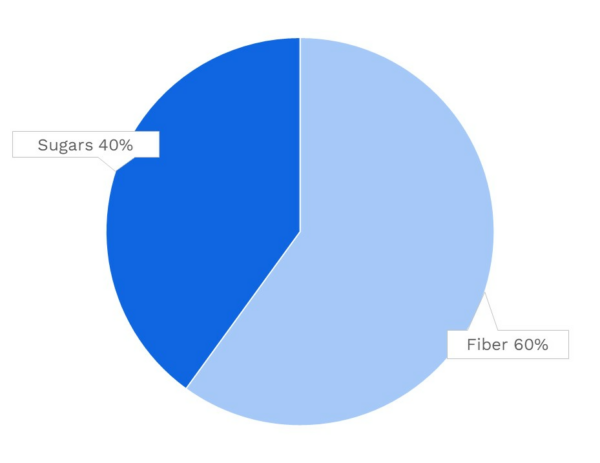
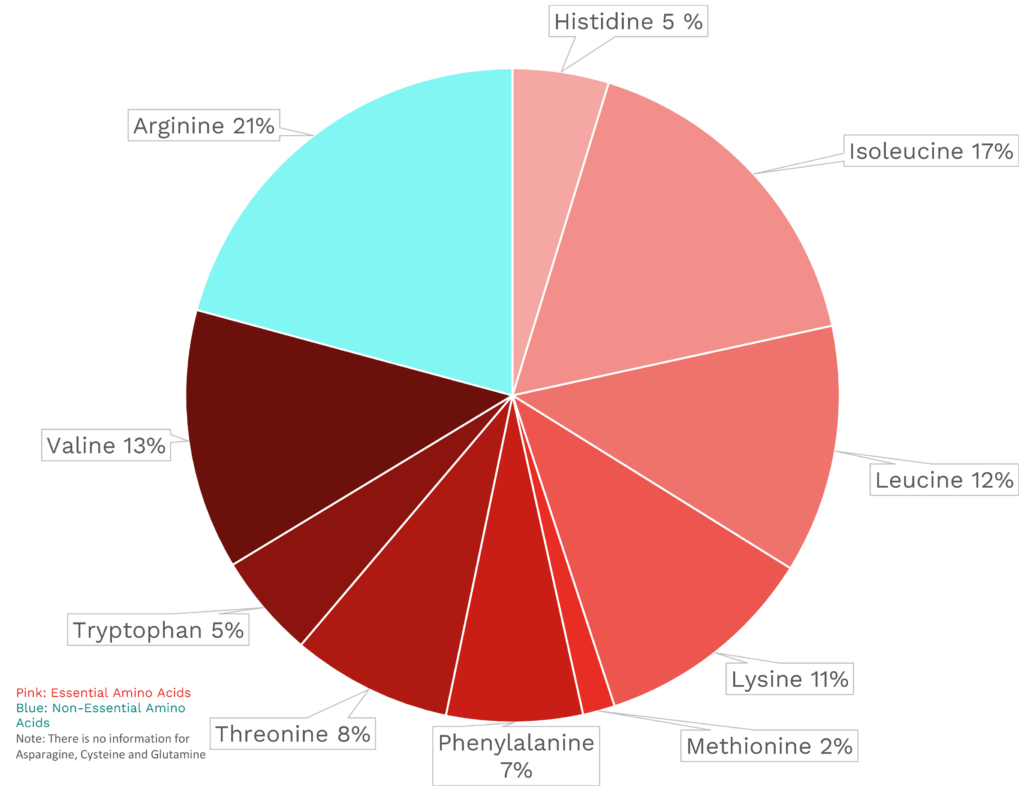
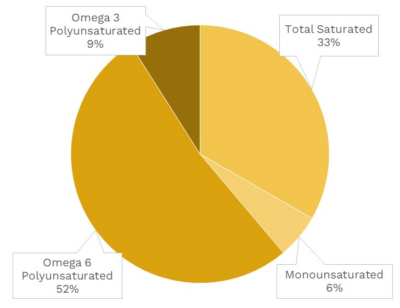
| VITAMINS | ||
|---|---|---|
| Vitamin A | 0.8 μg RAE | 0% DV |
| Vitamin B1 (Thiamin) | 12.8 μg | 1% DV |
| Vitamin B2 (Riboflavin) | 22.4 μg | 2% DV |
| Vitamin B3 (Niacin) | 0.2 mg | 1% DV |
| Vitamin B5 (Pantothenic Acid) | 0.2 mg | 4% DV |
| Vitamin B6 (Pyridoxine) | 45.6 μg | 3% DV |
| Vitamin B7 (Biotin) | ~ | ~ |
| Vitamin B9 (Folate) | 48.0 μg | 12% DV |
| Vitamin B12 (Cobalamin) | 0.0 μg | 0% DV |
| Vitamin C | 6.4 mg | 7% DV |
| Vitamin D (D2 + D3) | 0.0 μg | 0% DV |
| Vitamin E | 1.8 mg | 12% DV |
| Vitamin K | 204.2 μg | 170% DV |
| Choline | 8.7 mg | 2% DV |
| Myo-Inositol | ~ | ~ |
| CoQ10 | ~ | ~ |
| FUNCTIONAL FATS | ||
|---|---|---|
| MUFA | 0.0 g | 0% DV |
| ALA | 12.8 mg | 1% DV |
| EPA + DHA | 0.0 mg | 0% DV |
| CLA | ~ | ~ |
| Linoleic Acid | 0.1 g | 0% DV |
| MCT’s | 0.0 g | ~ |
| MINERALS | ||
|---|---|---|
| Calcium | 15.2 mg | 1% DV |
| Copper | 272.8 μg | 30% DV |
| Iodine | ~ | ~ |
| Iron | 0.5 mg | 3% DV |
| Magnesium | 10.4 mg | 2% DV |
| Manganese | 110.4 μg | 5% DV |
| Phosphorus | 32.0 mg | 3% DV |
| Potassium | 241.6 mg | 5% DV |
| Selenium | 0.7 μg | 1% DV |
| Sodium | 17.6 mg | 1% DV |
| Zinc | 0.5 mg | 5% DV |
| PHYTONUTRIENTS | ||
|---|---|---|
| Carotenoids | 7078.4 μg | ~ |
| Polyphenols | 807.9 mg | ~ |
| Phytosterols | ~ | ~ |
| Glucosinolates | ~ | ~ |
| Thiosulfinates | ~ | ~ |
| Betalains | ~ | ~ |
| AMINO ACIDS & PEPTIDES | ||
|---|---|---|
| Taurine | ~ | ~ |
| Ergothioneine | ~ | ~ |
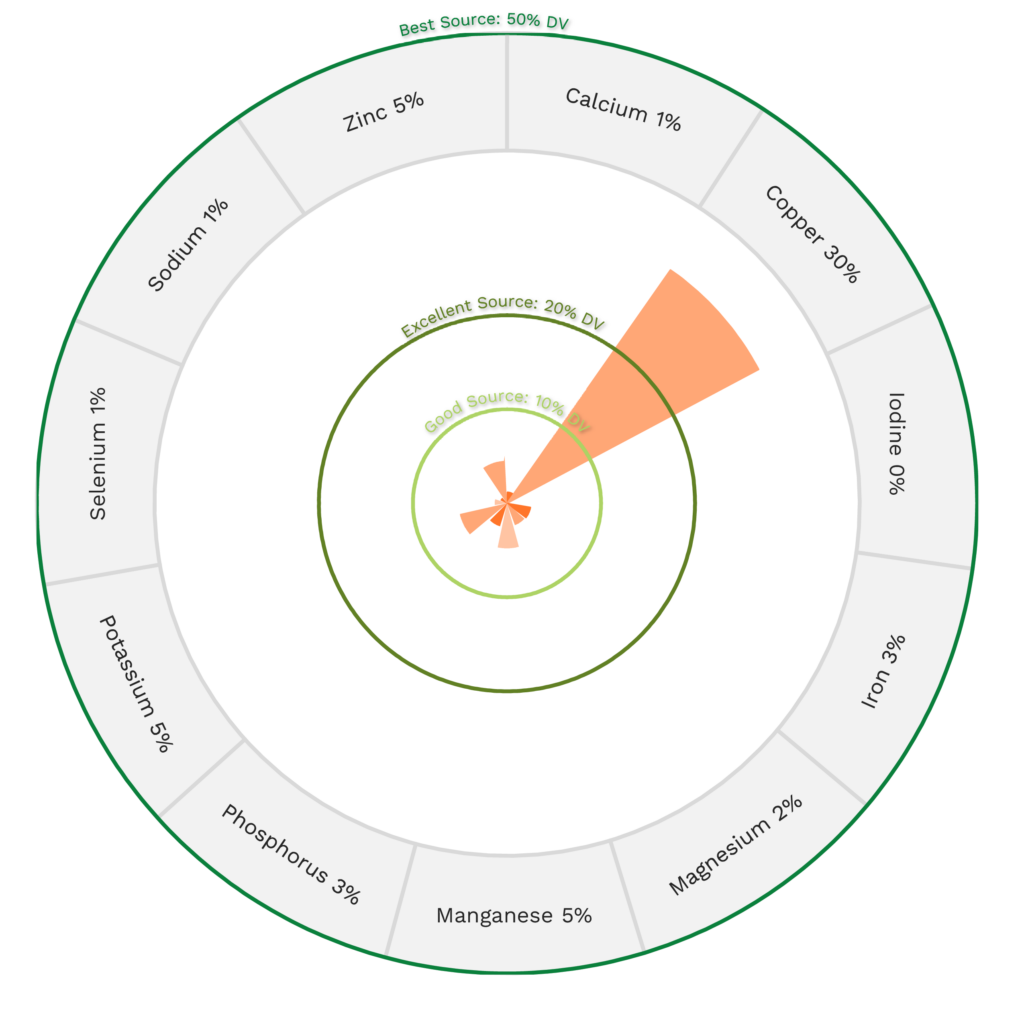
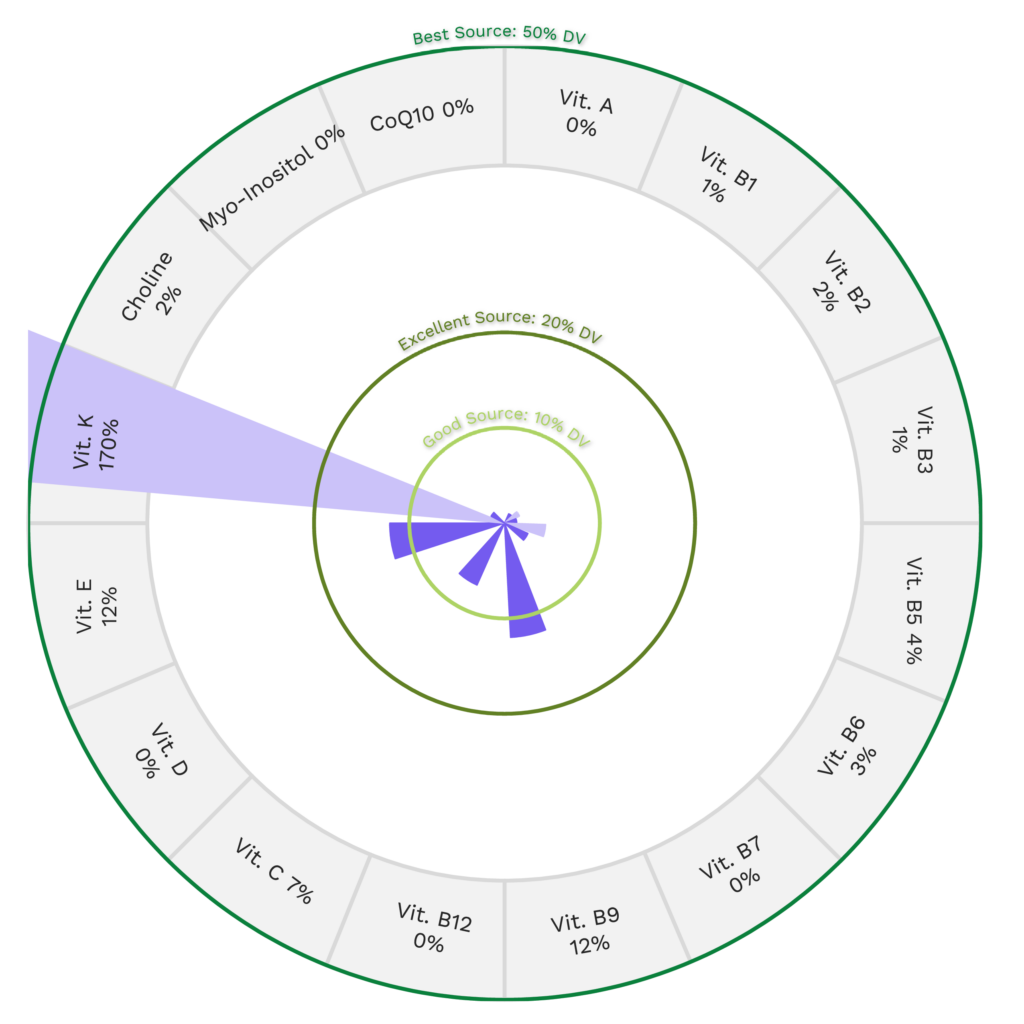
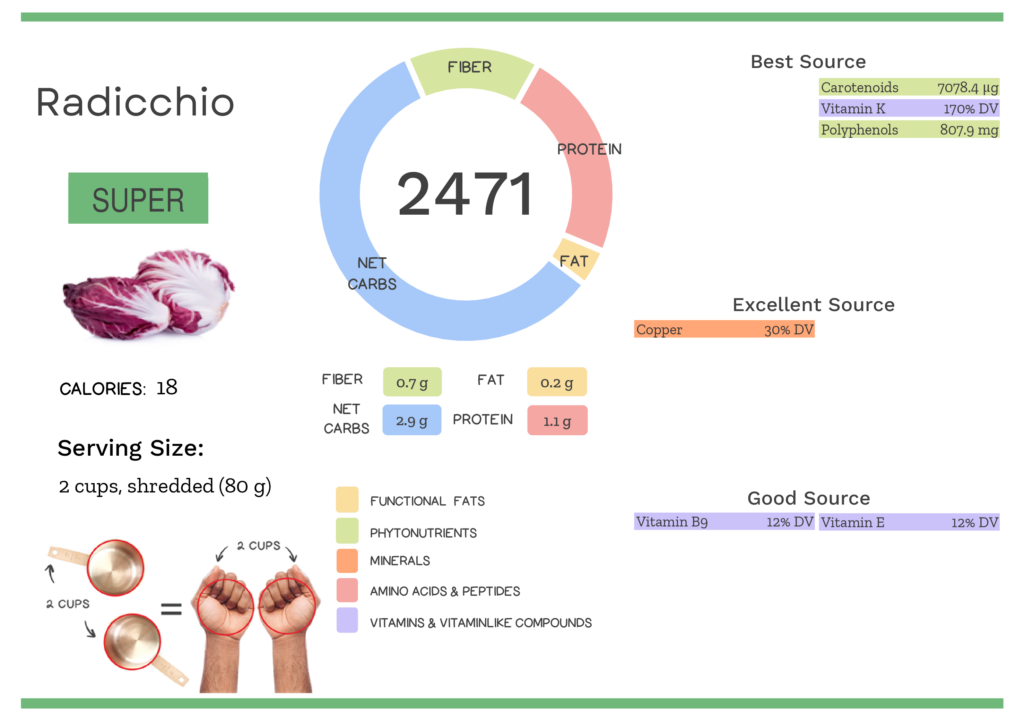
Impressed by the “radicchio-lous” amount of nutrition in radicchio? Maybe your friends will be too!
Health Benefits of Radicchio Nutrients
Let’s take a closer look at all of the best and excellent source of nutrients found in a 2-cup serving of radicchio and see how they benefit our health.
Radicchio Provides 170% DV Vitamin K
Radicchio is a phenomenal source of vitamin K, providing a whopping 170% of the daily value per 2-cup serving!
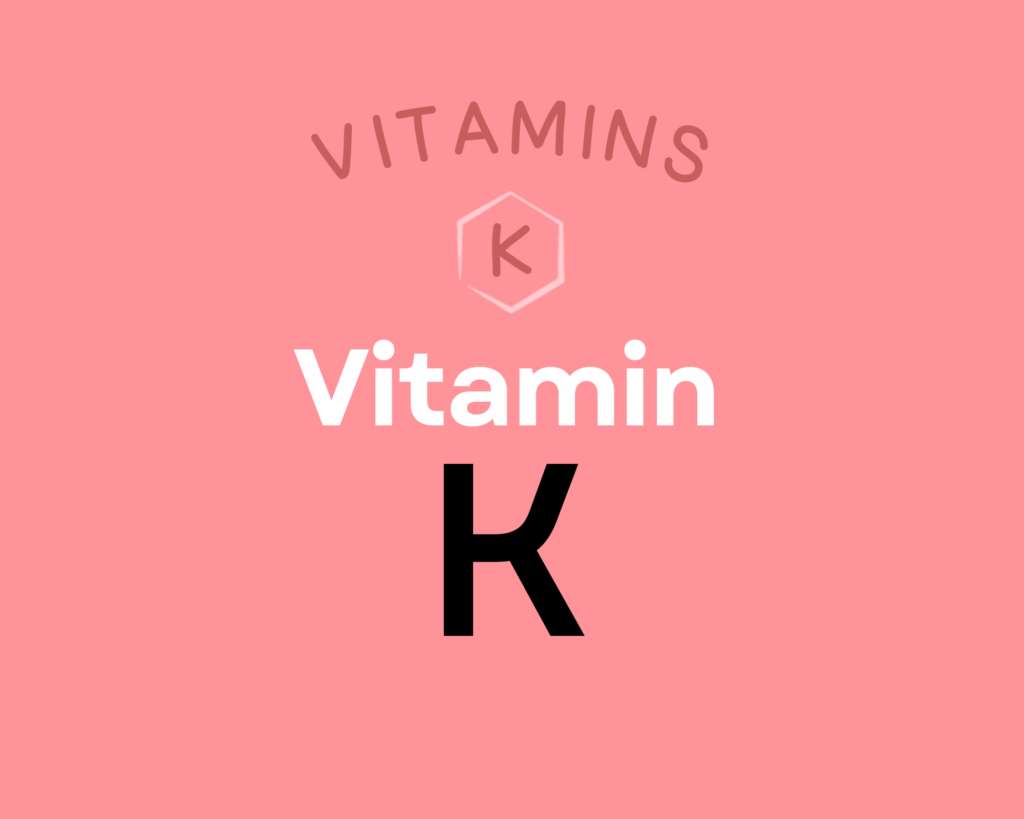
Vitamin K is actually a group of fat-soluble vitamins with a similar molecular structure, existing as K1, multiple isoforms of K2, and the synthetic form K3. This nutrient plays a vital role in coagulation, due to serving as a cofactor for proteins needed for blood clotting; it’s also essential for bone metabolism, cellular function, and the prevention of soft tissue calcification. Getting enough vitamin K2 can help protect against cardiovascular disease, may improve bone mineral density and skeletal health, and may even support endocrine function and brain health; there’s also some limited evidence it has anti-cancer and anti-inflammatory properties. Learn more about vitamin K here.
Radicchio Provides 807.9 mg of Polyphenols
Radicchio is an amazing source of beneficial phytonutrients, including polyphenols and carotenoids. A 2-cup serving of radicchio contains an impressive 807.9 mg of polyphenols!

Polyphenols play a huge role in protecting against cancer, heart disease, diabetes, asthma, osteoporosis, neurodegenerative diseases, and other conditions associated with oxidative stress. In fact, a major reason foods like red wine and olive oil (as well as diets rich in both, such as the Mediterranean diet) show up as so beneficial may be due to their high polyphenol content! Along with chronic diseases, supplementing with polyphenols has been shown to protect against infections and reduce the signs of aging. Polyphenols exert their most potent effects by acting as antioxidants—preventing cellular damage by neutralizing hazardous oxygen radicals and improving cellular health as a result (which, in turn, benefits virtually every system in the body). As a result of their antioxidant properties, polyphenols also boost the immune system and protect against both chronic and acute diseases. In addition, polyphenols can help regulate enzyme function, stimulate cell receptors, modulate the functions of inflammatory cells (including T and B lymphocytes, macrophages, platelets, and natural killer cells), alter adhesion molecule expression, affect nerve cells and cardiac muscle cells, and exert antiviral effects. Learn more about polyphenols here.
Radicchio Provides 7078.4 μg of Carotenoids
Radicchio contains 7078.4 μg of carotenoids per 2-cup serving.
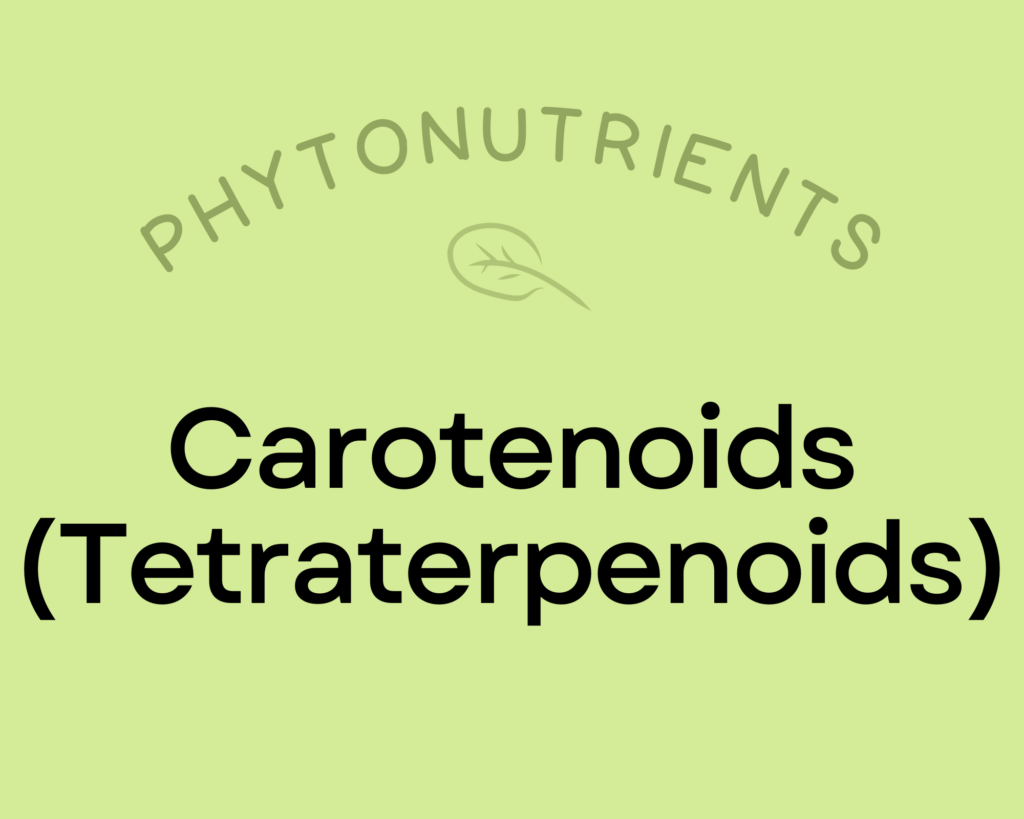
Carotenoids are a diverse group of phytonutrients that are responsible for giving fruits and vegetables vibrant red, orange, and yellow pigmentation. They were one of the earliest phytonutrients ever investigated by scientists (with research dating back to the 1800s!). Across studies, eating foods high in carotenoids appears to reduce the risk of head and neck cancers, supports vision health (particularly age-related eye diseases), may protect against metabolic syndrome and diabetes, and can reduce inflammation. Carotenoids have strong antioxidant properties, and help facilitate communication between cells by promoting the synthesis of connexin proteins, which create gap junctions in cell membranes that allow small molecules to be exchanged (which is part of how cells “talk” to each other!). Consuming carotenoids with fat significantly increases their absorption. Learn more about carotenoids here.
Radicchio Provides 30% DV Copper
Radicchio is also an excellent source of copper, providing 30% of the daily value per 2-cup serving.

Copper is a trace mineral that’s essential for all living organisms. Copper serves as a component of numerous enzymes and proteins in the body, giving it diverse roles in the growth, development, and maintenance of various organs (including the heart and brain), bone, and connective tissue. Copper is also involved in glucose and cholesterol metabolism, helps regulate gene expression, can scavenge free radicals, and is needed for the production of red blood cells. Learn more about copper here.
Learn What Foods Are the Best Sources of Every Nutrient

The Top 25 Foods for Every Nutrient
The Top 25 Foods for Every Nutrient e-book is a well-organized, easy-to-use, grocery store-friendly guide to help you choose foods that fit your needs of 43 important nutrients while creating a balanced nutrient-dense diet.
Get two “Top 25” food lists for each nutrient, plus you’ll find RDA charts for everyone, informative visuals, fun facts, serving sizes and the 58 foods that are Nutrient Super Stars!
Buy now for instant digital access.
How Much Radicchio Should We Eat per Day?
Leafy greens may come from a variety of different taxonomic families, but they all have one thing in common – when it comes to nutritional bang for calorie buck, they are hard to beat!
Every serving of fresh, whole vegetables or fruit we eat daily reduces the risk of all-cause mortality by 5% to 8%, with the greatest risk reduction seen when we consume five or more servings per day. In fact, consuming 800 grams of vegetables and fruits daily reduces all-cause mortality by 31% compared to eating less than 40 grams daily. A 2017 meta-analysis showed that 2.24 million deaths from cardiovascular disease, 660,000 deaths from cancer, and 7.8 million deaths from all causes could be avoided globally each year if everyone consumed 800 grams of veggies and fruits every day.
Eating vegetables and fruit in abundance lowers risk of cancer, cardiovascular disease, type 2 diabetes, obesity, chronic kidney disease, osteoporosis and bone fragility fractures (including hip fracture), cognitive impairment and dementia (including Alzheimer’s disease), neurodegenerative diseases, asthma, allergies, chronic obstructive pulmonary disease, age-related macular degeneration, cataracts, glaucoma, depression, ulcerative colitis and Crohn’s disease, rheumatoid arthritis, inflammatory polyarthritis, non-alcoholic fatty liver disease, acne, seborrheic dermatitis, and lowers markers of inflammation. Learn more in Importance of Vegetables and Fruit.
Covering half of your plate with a variety of vegetables (and three quarters of your plate if your starchy food is a root vegetable or winter squash) at each meal is a simple way to easily achieve the goal of 5 or more servings of vegetables daily.
One to two servings per day of leafy greens is a great target, but there doesn’t seem to be any downside to consuming way more than that!
Studies show that leafy greens (like radicchio) offer a huge range of scientifically demonstrated health benefits. For instance, for every 1/3 cup of leafy greens you eat each day you reduce the risk of type 2 diabetes by 13%. Leafy green consumption has also been associated with a 40% lower risk of death from colorectal cancer in men, a 16% reduction in cardiovascular disease and slower cognitive decline in elderly adults. Amazingly, an average of only 1.3 servings per day was associated with the equivalent of being 11 years younger in cognitive age! Taking this all into account means that one to two servings per day of leafy greens (like radicchio) is a great target, but there doesn’t seem to be any downside to consuming way more than that!
Just remember, it’s always best to mix up the veggies you eat day to day (aiming for a wide variety of different vegetables and fruits throughout the week), and radicchio definitely has a place at the table.
Easily track your servings of Nutrivore Foundational Foods!

The Nutrivore Weekly Serving Matrix
The Nutrivore Weekly Serving Matrix digital resource is an easy-to-use and flexible weekly checklist designed to help you maximize nutrient-density and meet serving suggestions of Nutrivore foundational foods, all without having to weigh or measure your foods!
Includes a 22-page instructional guide and downloadable interactive guides.
Buy now for instant digital access.
Citations
Expand to see all scientific references for this article.
Innocenti M, Gallori S, Giaccherini C, Ieri F, Vincieri FF, Mulinacci N. Evaluation of the phenolic content in the aerial parts of different varieties of Cichorium intybus L. J Agric Food Chem. 2005 Aug 10;53(16):6497-502. doi: 10.1021/jf050541d. PMID: 16076140.
USDA Food Central Database: Radicchio, raw


